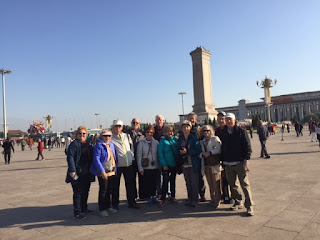At 24 million residents it is one of the largest metropolitan areas in the world.
Today we saw Tiananmen Square and The Forbidden City.
At the historical heart of Beijing lies the Forbidden City, the enormous palace compound that was the home of the emperors of the Ming and Qing dynasties; the Forbidden City hosts the Palace Museum, which contains imperial collections of Chinese art. Surrounding the Forbidden City are several former imperial gardens, parks and scenic areas, notably Beihai, Shichahai, Zhongnanhai, Jingshan and Zhongshan. These places, particularly Beihai Park, are described as masterpieces of Chinese gardening art,and are popular tourist destinations with tremendous historical importance; in the modern era, Zhongnanhai has also been the political heart of various Chinese governments and regimes and is now the headquarters of the Communist Party of China and the State Council. From Tiananmen Square, right across from the Forbidden City, there are several notable sites, such as the Tiananmen, Qianmen, the Great Hall of the People, the National Museum of China, the Monument to the People's Heroes, and the Mausoleum of Mao Zedong. The Summer Palace and the Old Summer Palace both lie at the western part of the city; the former, a UNESCO World Heritage Site, contains a comprehensive collection of imperial gardens and palaces that served as the summer retreats for the Qing imperial family.
 |
| Forbidden City |
Tiananmen Square - At 100 acres, it is the world's largest public square
Tiananmen Square
The square contains the Monument to the People's Heroes, the Great Hall of the People, the National Museum of China, and the Mausoleum of Mao Zedong. Mao Zedong proclaimed the founding of the People's Republic of China in the square on October 1, 1949; the anniversary of this event is still observed there. It has great cultural significance as it was the site of several important events in Chinese history. Outside China, the square is best known for the Tiananmen Square Massacre, an armed suppression of a pro-democracy movement in June 1989.




No comments:
Post a Comment